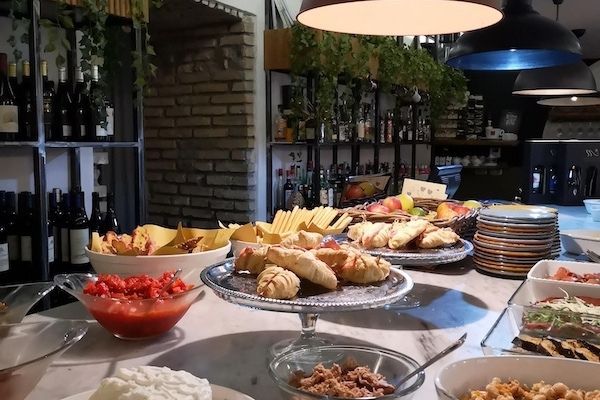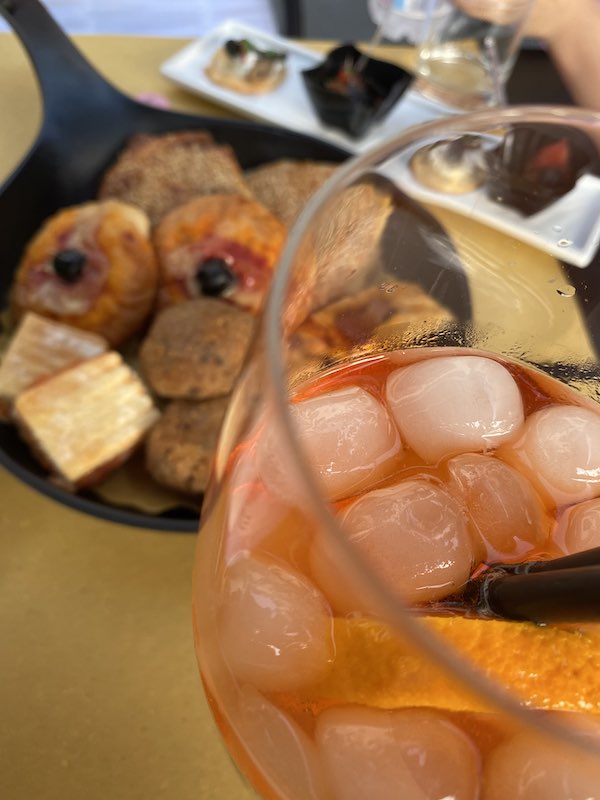
Italian aperitivo: all you ever wanted to know + how to make it at home
All you need to know about Italian aperitivo. Its history, origins, traditional Italian aperitivo drinks and foods and tips to recreate this Italian tradition at home.
Aperitivo is a very popular and much beloved Italian tradition.
Born in the aristocratic circles of Piedmont, the tradition is now embraced everywhere in the Italian peninsula and sees variations that depend on the season and the local produce of each region, something no form of real Italia cuisine ever ignores.
Enjoying aperitivo is easy and can be done at all ages.
While many think of aperitivo as based on the consumption of alcohol, there is really no reason why that should be the case and many non alcoholic aperitivo drinks exist, perfect to make this tradition accessible to absolutely everyone.
This is all you need to know about Italian aperitivo, including what it is, popular Italian aperitivo drinks and foods and tips for replicating at home.
Related: learn how to say cheers in Italian here
What is Italian aperitivo? Italian aperitivo meaning
Aperitivo is the tradition of meeting up for a pre-dinner drink and some small plates of food usually in a bar or a cafe, rather than a restaurant, offered in the form of a food buffet.
Good to know: in 2020, health and safety regulations have changed and buffets are not allowed anymore. Aperitivo is however still served in the same spirit, the choice of food now being delivered to your table.
In English, you often see aperitivo translated as ‘happy hour’ however, this is not entirely correct.
Happy hour usually means that you get a discount on food and drink orders, or if you order a combination of drinks, the emphasis being on the good deal you get.
When it come to aperitivo, indeed you do get some food thrown in with your order, at a fraction of the price of dinner, but the emphasis is not on he saving but on the type of food and drink involved, the time and the setting of the experience.
Aperitivo is a traditional that has its origins in the late 1700s and the best way to learn what makes it special and the spirit as its base it to look at its history and then deep dive into the special drinks foods and snacks.
This is all that makes Italian aperitivo special.

Where is aperitivo from? A quick history of Italian aperitivo
Aperitivo has a long story, and it is said to have been born in Turin (Torino), Piedmont, 1796.
That year, a wine merchant called Antonio Benedetto Carpano learned that an ancient tradition recommended drinking aromatic wine before dinner as a remedy to medical ailments and to open the stomach to facilitate digestion, and set to create a drink with characteristics similar to the ancient concoction.
He created an aromatic, slightly bitter drink, put it into a a fancy bottle and gave this creation the name ‘vermouth’ (Or Vermut, Wermouth, or Wermuth from the German name of its main ingredient, Arthemisia absinthium).
He then proceeded to present it to King Vittorio Emanuele, who immediately became a fan.
The king is said to have particularly appreciate the slightly bitter taste of the drink, a taste that in local dialect he described as having a ‘punt e mes‘ (a point and a half) of bitter and indeed, a rather bitter taste is still now at the basis of most aperitivo drinks.
Aperitivo = from the verb aprire, to open = to open/prepare the stomach for digestion.
The expression punt a mes was quickly adopted as the new name of a the Vermut and the drink quickly got into the favors of the Italian aristocracy and sparked the birth of many aperitivo creations by drink makers of now world-wide fame such as Campari and Ramazzotti.
From Torino, the use of meeting up for aperitivo soon spread to Milano, where in 1900 meeting up for aperitivo became a real social phenomenon, so much so that nowadays aperitivo is most associated with the city of Milan, despite its Piedmont origins.
The number of available drinks became wider, both in alcoholic and non-alcoholic form and they started being accompanied by a small plate of olives and then by more elaborate snacks, slowly resembling a proper buffet.
Despite this growth, aperitivo always maintained that lightness and that sense of indulgence typical of its aristocratic beginnings and is still now a light extra to be enjoyed before dinner, not a substitute for a meal.
At what time do you drink aperitivo in Italy?
In Italy, you usually have aperitivo between 6.30 and 8.30pm (the time is not rigid).
Depending on the establishment, it can be a quick affair with a drink, some crisps, olive and peanuts or a full buffet and can be enjoyed, traditionally, sitting at the bar or sitting down.
In Milan and now more and more often in the rest of Italy too, Aperitivo is not a pretty rich affair with food ranging from grissini col prosciutto (bread sticks with Parma ham) to pasta salads, crostini and more.

Popular Italian aperitivo drinks
There is a vast choice of drinks you can order for Italian aperitivo, both with alcohol and without.
Some of the most popular alcoholic ones are:
- Spritz (soda, prosecco and Aperol or Campari) – this is probably the most popular type of Italian aperitivo drink at present. Aperol spritz was born in Veneto while the Campari variation is said to be born in Milan. Find the full recipe for Campari Spritz, Aperol Spritz and non-alcoholic spritz
- Bellini (prosecco and peach puree), an elegant aperitivo drink served in a flute, born in the elegant Harry’s Bar in Venice
- Hugo, a refreshing summer aperitivo drink with prosecco and melissa or elderflower, from Alto Adige
- Americano (gin, Vermouth rosso, soda)
- Negroni (gin, Vermouth and Campari): this is a strong cocktail, often preferred after dinner but not uncommon as aperitivo as well
- Negroni sbagliato (spumante, Vermouth, Campari)
- Martini Dry (gin, vermouth, orange zest, green olive)
- White wine (sparkling wine or white wine both acceptable)
- Beer
Some of the most popular nonalcoholic aperitivo Italian drinks in Italy are:
- Campari soda
- Aperol soda
- Crodino
- Sanbitter bianco or rosso
- Chinotto
- Tomato Juice (often ‘condito’ aka dressed with tabasco and lemon)
Popular Italian aperitivo foods
- Roasted peanuts
- Crisps
- Pistacchio nuts
- Assorted bruschette or crostini (grilled bread with fresh tomatoes, vegetable or meant spreads and pates, etc)
- Bread sticks and parma ham
- Prosciutto e melone (parma ham and melon)
- Pizzette (mini pizza, with several types of toppings)
- Mini mozzarella balls, fried or plain
- Cold vegetable frittata (served in slices or cubes),
- Italian sausage roll
- Vegetable pies (in slices or mono portions)
- Cold pasta salad
- Cold rice salad
How to make Italian aperitivo at home
When Italy feels unbearably far away, it is also possible to recreate aperitivo at home.
When I do it, I like to stay true to the spirit of aperitivo creating bite size portions and a generous buffet but also love to mix traditional drinks with more original ones.
Ultimately, aperitivo is about coming together around good food so if there is a traditional Italian cocktail you like, you can most definitely offer it during your aperitivo with friends!
To make the table beautiful and welcoming, I like to use nice glassware, usually large stem glasses for spritz and wine, old fashioned glasses for heavier drinks such as Negroni and tumblers for juices and soda.
Drinks that work well are:
- Campari soda
- Aperol soda
- Sanbitter Bianco or Rosso
- Bottled beer (Italian brands such as Menabrea, Moretti, Ichnusa and Peroni Nastro Azzurro all work well)
- Aperol or Campari Spritz
- Americano / Negroni / Negroni sbagliato cocktail
- Bellini
- White wine
- Prosecco
- Chinotto (non alcoholic)
- Tomato juice, dressed
- Assorted juices
Foods that work well to make Italian aperitivo at home are:
- Cold cuts and cured Italian meats (prosciutto, salame)
- Taralli
- Bread sticks
- Dips such as hummus and guacamole that, while not Italian, work well with an Italian aperitivo setup
- Olives
- Caprese salad (tomato and mozzarella)
- Frittata
- Cold pasta salad / rice salad /couscous salad
I hope you enjoyed this quick overview of the history and tradition of Italian aperitivo and it inspired you to try it! Interested in after dinner drinks too? Then also check out our article about Italian digestifs here.




